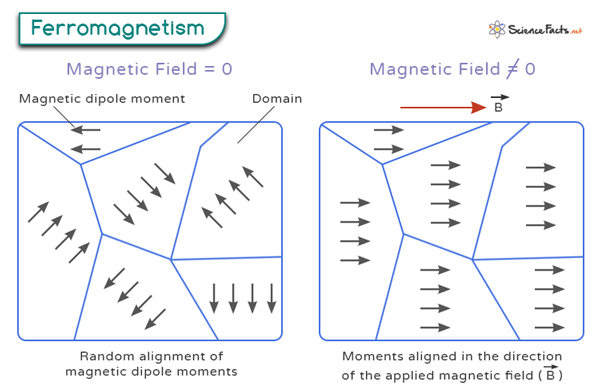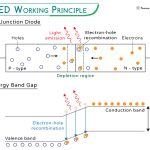Ferromagnetism
Ferromagnetism is an exciting phenomenon observed in certain materials, known as ferromagnetic materials, that can retain their magnetization even after removing an external magnetic field. Ferromagnetic materials can become ferromagnets and interact strongly with other magnets and magnetic fields. A characteristic of ferromagnetic materials is their magnetization ability, distinguishing them from paramagnetic and diamagnetic materials, where weak magnetism exists temporarily.
This unique property allows for making permanent magnets widely used in various applications such as motors, generators, speakers, and data storage devices. The ability to generate and maintain a magnetic field without the need for a constant external source of power makes ferromagnets highly valuable.
How Does Ferromagnetism Work
The concept of ferromagnetism stems from the alignment of magnetic moments of the atoms within the material. Magnetic moments are tiny regions of electron spins that generate a magnetic field. A characteristic of the atoms of a ferromagnetic material is that they have permanent dipole moments. When placed in an external magnetic field, the magnetic moments align with the applied field, resulting in magnetization. Therefore, ferromagnetism is only possible when atoms are arranged in a lattice and their magnetic moments interact to align parallel to the applied field.
Properties of Ferromagnetic Materials
Here are some fundamental properties of ferromagnetic materials:
- Magnetization: Ferromagnetic materials can be easily magnetized and retain their magnetization even after removing the magnetizing field. This property is known as hysteresis.
- Saturation: Ferromagnetic materials have a saturation point, beyond which a further increase in the applied magnetic field does not significantly increase magnetization. The material is fully magnetized at saturation.
- Curie temperature: Ferromagnetic materials have a specific temperature called the Curie temperature, above which they lose their ferromagnetic properties and become paramagnetic. Below the Curie temperature, these materials exhibit strong magnetic behavior.
- Domains: Ferromagnetic materials are composed of small regions called domains, where the magnetic moments are aligned in the same direction. The alignment of these domains determines the overall magnetization of the material.
- Magnetic hysteresis: Ferromagnetic materials exhibit magnetic hysteresis, which refers to the lagging of magnetization behind changes in the applied magnetic field. This lag results in energy losses and is utilized in various applications such as transformers and electric motors.
- High permeability: Ferromagnetic materials have high permeability, allowing magnetic fields to pass quickly. This property makes them helpful in shielding against electromagnetic interference and creating magnetic circuits.
Examples of Ferromagnetic Materials
Here are some examples of ferromagnetic metals and compounds:
- Iron is perhaps the most well-known and widely used ferromagnetic material. It is highly magnetic and forms the basis for many industrial applications, including electromagnets and transformers.
- Nickel is another common ferromagnetic material with strong magnetic properties. It is often alloyed with other metals to enhance its performance in various applications, such as producing stainless steel.
- Cobalt is a naturally occurring ferromagnetic element with a high Curie temperature. It is useful in high-temperature applications where other materials may lose their magnetism.
- Metallic Alloys: Several metallic alloys also display ferromagnetism to varying degrees. For example, alloys like Alnico (aluminum-nickel-cobalt) and Permendur (iron-cobalt-vanadium) are widely used to manufacture permanent magnets.
- Rare Earth Elements: Rare earth elements like neodymium and samarium exhibit strong ferromagnetic properties at room temperature. These elements are crucial in producing powerful permanent magnets used in various industries.
FAQs
Ans. No, magnets do not repel ferromagnetic materials.
Ans. Ferromagnetic materials can be magnetized by placing them in a strong external magnetic field or passing an electrical current.
-
References
Article was last reviewed on Friday, September 15, 2023







